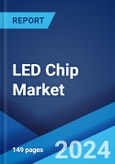LED stands for light emitting diode, which is a two-lead semiconductor light source. These are used in a wide range of applications that vary from backlighting in electronic products such as LCD TVs, laptops, and phones, as well as in street lighting and automotive lighting, and general illumination. This can be attributed to the better picture quality offered by LEDs due to their higher degree of power efficiency and brightness. The LED chip, also known as the die, represents the most essential and cost-intensive component of the LED. It is a critical factor in determining the light quality. The chips have different ratings for brightness, wavelength and voltage. After installing the LED chip and passing current through an electrical source, a particular color of light is emitted, which is determined by the dominant wavelength.
These lights are more energy-efficient in terms of power consumption and provide high luminous intensity. They use electroluminescence to produce light without generating heat and convert electricity into energy with minimum wastage. Furthermore, these products have a longer lifespan as compared to incandescent bulbs, which further drives their demand. However, with technological innovations and research and development, the cost of manufacturing LEDs per kilolumen has decreased. This has significantly reduced the average selling price (ASP) of LEDs, making them a preferred choice among consumers. Moreover, incentives provided by governments across the globe to promote the usage of energy-efficient lighting is also elevating the demand for LED products.
Market Segmentation
This report provides an analysis of the key trends in each segment of the global LED chip market, along with forecasts at the global and regional levels from 2025-2033. The market has been categorized based on product and application.Breakup by Product
- Blue LED Chips
- Red LED Chips
- Green LED Chips
- Infrared LED Chips
- Yellow LED Chips
- White LED Chips
- Others
Breakup by Application
- Backlighting
- Illumination
- Automotive
- Signs and Signal
- Others
Breakup by Region
- Asia Pacific
- North America
- Europe
- Middle East and Africa
- Latin America
Competitive Landscape
The competitive landscape of the market is characterized by the presence of numerous small and large manufacturers who compete in terms of prices and quality. Some of the leading players operating in the market are:- AVA Technologies, Inc.
- Bright LED Electronics Corporation
- Cree, Inc.
- Bridgelux, Inc.
- Hitachi Cable, Ltd.
- Huga Optech, Inc.
- Dowa Electronics Materials Co., Ltd.
- Epistar Corporation
- Nichia Corporation
- Formosa Epitaxy, Inc.
- Goldeneye, Inc.
- Kingbright Electronic Co. Ltd.
- Optek Technology (TT Electronic PLC)
- OSA Opto Light GmbH
- Osram Opto Semiconductors GmbH
Key Questions Answered in This Report
1. How big is the global LED Chip market?2. What is the expected growth rate of the global LED chip market during 2025-2033?
3. What are the key factors driving the global LED chip market?
4. What are the key regions in the global LED chip market?
5. Who are the key players/companies in the global LED chip market?
Table of Contents
Companies Mentioned
- AVA Technologies Inc.
- Bright LED Electronics Corporation
- Cree Inc.
- Bridgelux Inc.
- Hitachi Cable Ltd.
- Huga Optech Inc.
- Dowa Electronics Materials Co. Ltd.
- Epistar Corporation
- Nichia Corporation
- Formosa Epitaxy Inc.
- Goldeneye Inc.
- Kingbright Electronic Co. Ltd.
- Optek Technology (TT Electronic PLC)
- OSA Opto Light GmbH
- Osram Opto Semiconductors GmbH
Methodology

LOADING...
Table Information
| Report Attribute | Details |
|---|---|
| No. of Pages | 136 |
| Published | February 2025 |
| Forecast Period | 2024 - 2033 |
| Estimated Market Value ( USD | $ 31.26 Billion |
| Forecasted Market Value ( USD | $ 81.67 Billion |
| Compound Annual Growth Rate | 11.3% |
| Regions Covered | Global |
| No. of Companies Mentioned | 15 |









